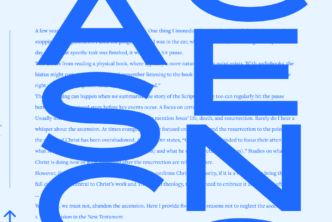This post has been adapted from The Bible Unfiltered by Dr Michael S. Heiser.
We’ve all heard the old saying that certain things get better with age—wine, cheese, common sense. Anyone who’s watched Antiques Roadshow also knows that the longer you have something that there’s a demand for—real estate, investments, fine art, a popular car—the more value it will accrue. Unfortunately, the reverse is true for many of the most popular tools for biblical study. They’re often more like tech gear—they get worse with age and sometimes become totally obsolete.
Commentaries are one of the tools that don’t get better with the passage of time. The reasons are pretty simple. Biblical scholars are like experts in any field. They keep thinking and researching. The data of biblical studies increase and improve. Archaeology produces more discoveries of relevance. Computer technology makes ancient language analysis more thorough (and faster). Information becomes more accessible and searchable.
It’s no exaggeration to say that what scholars had access to 100 years ago is literally a fraction of what’s available to you today using only a smartphone. In terms of what previous generations were capable of analyzing in a lifetime, we can surpass with a few hours of effort.
I work closely with the world’s leading Bible software company and am used to the staggering realities of the modern world for biblical studies. But the truth I’m talking about today was brought home to me in a direct way only recently. My book The Unseen Realm: Recovering the Supernatural Worldview of the Bible devotes a lot of space to a lot of weird passages. One of the strangest is Genesis 6:1–4, the episode in the days of Noah where the “sons of God” (called the “Watchers” in Jewish literature written during the time between the Testaments) transgress the boundary between heaven and Earth in an illicit relationship with the “daughters of humankind.” The act produced the Nephilim, who are the forebears of the giant clans encountered by Moses and Joshua (Num 13:32–33).
There have been many attempts to strip this passage of its supernatural elements to make it palatable to modern Bible students. Since this sort of material has been my academic focus for the past 15 years, I can tell you that all such attempts have significant flaws of exegesis and logical coherence. But the greatest flaw is that any view that humanizes the sons of God and denies the unusual nature of the Nephilim invariably violates the passage’s original context and polemic meaning.
Prior to 2010, that assertion may have been contestable. That is no longer the case. Recent scholarly work on Mesopotamian literature associated with events before and after the great flood have produced clear, unambiguous, point-for-point parallels to what we read in Genesis 6:1–4. Those parallels demonstrate with no uncertainty that this biblical passage was specifically written to denigrate Mesopotamian ideas of the superiority of their gods and culture.
In the Mesopotamian material, the divine beings who lived at the time of the flood were called apkallu. They cohabited with human women, producing a new generation of apkallu who were not only divine-human hybrids but also giants. Mesopotamian religion saw these generations of apkallu as great sages. Their survival via human women before the annihilation of the flood preserved pre-flood divine knowledge that had been taught to men. This knowledge was preserved in Babylon, which explained (to the Mesopotamian cultures) why their culture was superior to all others. Rather than deny the supernatural context of the Mesopotamian material, Genesis hits it head-on. The apkallu were not saviors. They were undeserving rivals to Yahweh of Israel and deserved to die. After the flood the giant apkallu became enemies of God’s people, the Israelites. Whether we realize it or not, Genesis 6:1–4 reports the first salvo in the long war against Yahweh and his people. This strange passage that modern readers keep at arm’s length has hooks into other biblical passages, including the New Testament.
This new research comes from a thorough reexamination of the Sumerian and Akkadian flood epics. The insights were skillfully culled by cuneiform scholar Amar Annus in a 2010 journal article. Annus’ article is the most current study on the Mesopotamian apkallu available anywhere in any form. It supersedes all preceding work on this subject. It deals a death blow to any nonsupernatural interpretation of Genesis 6:1–4.
What this means is that every commentary on Genesis you’ve come to trust can no longer be trusted on this passage because it was written before this new, groundbreaking research. They’re like 8-track tapes—obsolete. The good news is that my book The Unseen Realm interacts with this new research at length. And there are a lot of issues like this one where I draw on recent research and provide a more up-to-date discussion than most commentaries. If you care about interpreting the Bible in its original context—including the supernatural worldview of the biblical writers—you should care about the latest insights from research on the ancient world.
The author’s views do not necessarily represent those of Faithlife.
***

Dr. Michael S. Heiser is the author of The Unseen Realm: Recovering the Supernatural Worldview of the Bible and Angels: What the Bible Really Says about God’s Heavenly Host.
His newest book, The World Turned Upside Down: Finding the Gospel in Stranger Things, is now on pre-order.
He’s taught many Mobile Ed courses, including Problems in Biblical Interpretation: Difficult Passages I.





